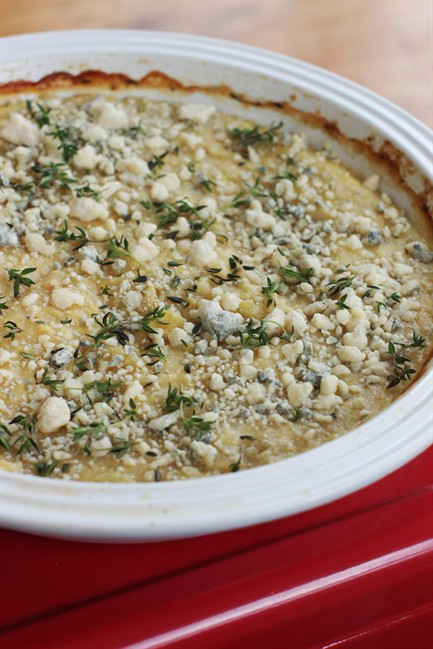We call it cornmeal mush. The Italians call it polenta. And they’ve been making it since shortly after Columbus introduced corn to the Old World upon his return from America.

At its most simple, polenta requires exactly two ingredients: cornmeal and a liquid. Sometimes fat or seasonings are added. Traditionally, it is prepared by bringing the liquid to a boil in a saucepan, adding the cornmeal in a slow, steady stream, then simmering the resulting mush, stirring constantly until it thickens. The whole process takes 30 to 40 minutes.
But let me be honest with you. That is not the way I make it. First, I’m not inclined to babysit a dish for 40 minutes. Secondly, I am not a fan of polenta’s tendency to splatter as it cooks. That mush is hot!
Happily, a stewardess on a plane tipped me off years ago about a hands-free, eruption-free way to cook polenta. She said she simply tosses all of the ingredients into a casserole dish and bakes them. I was skeptical. No way it could be that easy. But I tried it out and she was right. I’ve been making polenta in the oven instead of on the stove ever since.
There are many kinds of cornmeal at the grocer these days, fine, medium or coarse grain, stone ground, organic, some just labeled polenta, and in both white and yellow varieties. They all behave slightly differently when cooked, but they all can be used to make polenta. Texture-wise, fine-ground cornmeal turns out smoother and creamier, while coarser cornmeal is more granular. I like both. It takes a little longer to cook the coarser variety, and you’ll need to use a little more water.

Get breaking National news
Timing-wise, the vessel in which you cook the polenta makes a huge difference. If you use a casserole dish (earthenware or enameled cast-iron), the timing will work out pretty much as I explain in the recipe because those dishes heat up evenly from the bottom to the top. However, if you use a stainless steel pot (even one with aluminum or copper in the bottom), the polenta will take much longer to cook. Not to worry, though. If that’s the only pot you have, the polenta will still be great.
Where does polenta fit into the meal? It can be served as a first course, perhaps topped with sauteed mushrooms. It can act as a main course partnered with the pasta sauce of your choice. It provides the perfect bed for sauteed shrimp or lamb, as well as for beef or chicken stew. Finally, it’s a great absorber of the meat juices generated by a roast. In short, polenta is wildly versatile.
BAKED POLENTA
Start to finish: 1 hour (5 minutes active)
Servings: 6
- 1 cup fine- or medium-grain cornmeal
- 4 to 4 1/2 cups water, low-sodium chicken broth or stock, or vegetable broth, or a combination
- 1 teaspoon kosher salt
- 1 tablespoon unsalted butter
Heat the oven to 350 F.
In a 2-quart casserole dish, combine all the ingredients (use 4 cups liquid for fine cornmeal, and 4 1/2 cups for medium cornmeal). Stir the mixture briefly, then bake, uncovered, on the oven’s middle shelf until thick and creamy, about 45 minutes if it is fine cornmeal and 1 hour if it is medium cornmeal. The polenta should have the texture of a thick porridge; if it is too thin, put it back in the oven and let it bake until it reaches the desired consistency, checking it at 15-minute intervals.
When the polenta is done, stir well and serve right away.
Nutrition information per serving: 100 calories; 25 calories from fat (25 per cent of total calories); 2.5 g fat (1.5 g saturated; 0 g trans fats); 5 mg cholesterol; 380 mg sodium; 16 g carbohydrate; 1 g fiber; 0 g sugar; 3 g protein.
POLENTA EMBELLISHMENTS:
- ONION: In a small skillet over medium heat, saute 1/2 cup finely chopped onion in 2 tablespoons butter until softened. Add 2 teaspoons minced garlic and 1 tablespoon chopped fresh thyme, then cook, stirring, for 1 minute. Add the onion mixture to the casserole with all the remaining ingredients and follow the recipe as written. When the polenta is done, stir in 1 ounce finely grated Parmesan cheese (or another crumbled or diced cheese of your choice, such as Gorgonzola or fontina).
- MUSHROOM: Top the creamy polenta with 1/2 pound assorted sliced mushrooms sauteed in butter with minced shallot or onion and finished with truffle oil and chopped fresh herbs.
EDITOR’S NOTE: Sara Moulton is the host of public television’s “Sara’s Weeknight Meals.” She was executive chef at Gourmet magazine for nearly 25 years and spent a decade hosting several Food Network shows, including “Cooking Live.” Her latest cookbook is “Home Cooking 101.”





Comments